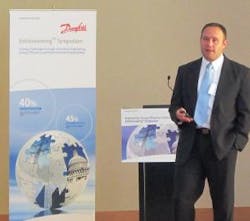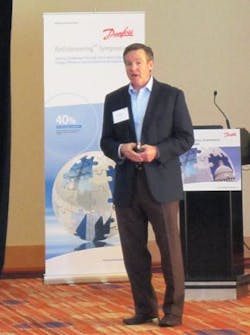The 20th Danfoss EnVisioneeringSM Symposium — “The Climate and Energy Nexus in Commercial Refrigeration — held on September 11 in Baltimore, convened commercial refrigeration manufacturers, supermarket chains, contractors, utilities, regulators, and industry associations, in a look at major issues shaping the commercial refrigeration industry. Issues discussed included refrigerant policy-making, which is driven by shifts in technology, and international negotiations.
JamesBoyle, senior vice president, electronic controllers and services for Danfoss, provided a fitting prologue to the event, by stating, “The confluence of trends such as increased regulatory pressure, ever-increasing energy costs, contractor training, and consumer pressure on sustainability illustrate that we are in the midst of a shift in how supermarkets and commercial refrigeration equipment used in all food services are designed, built and installed.”
Event presenters included:
- Drusilla Hufford, Director, Stratospheric Protection Division, U.S. Environmental Protection Agency (EPA)
- Kevin Fay, President, Alcalde & Fay, and special counsel to the Alliance for Responsible Atmospheric Policy
- Keilly Witman, vice president, marketing, EOS Climate, and former head of EPA’s GreenChill Partnership
- Daryl Erbs, director of engineering, Manitowoc Ice
- Scott Martin, director, sustainable technologies, Hillphoenix
- Charles Holcomb, segment manager, Duke Energy
- Jeff Staub, application engineering manager, Danfoss.
The Effect of Emerging Policy on Refrigerants
The symposium took place on the heels of the agreement between President Obama and President Xi of China to use “the expertise and the institutions of the Montreal Protocol to phase down the production and consumption of hydrofluorocarbons (HFCs).” That event sharpened the focus on the need to plan for an HFC phasedown and the adoption of low global warming potential (GWP) alternatives.
According to Keilly Witman, it is likely the industry will see an amendment to the Montreal Protocol for implementing an HFC phasedown, as well as movement under EPA’s SNAP program to delist high-GWP refrigerants. However, Witman advised industry members to not be distracted from a refrigerant management plan in the short-term. The industry should begin concentrating today on phasing out R-22 used in supermarkets, and choose the lowest GWP refrigerant that meets performance needs for both R-22 retrofits and new construction.
As part of President Obama’s June 2013 “Climate Action Plan,” he directed EPA to exercise its authority through the Significant New Alternatives Policy (SNAP) Program to reduce emissions of HFCs in the United States. SNAP is EPA’s legislatively-mandated process to evaluate and approve alternatives to ozone-depleting substances.
While many in the industry believe that using SNAP as a vehicle to phase down HFCs would reach beyond the program’s intended purpose and likely would be cumbersome and ineffective, it is viewed as a first step toward reducing HFCs in the United States.
Anticipating Uncertainties through Management, Engagement
EPA’s GreenChill program is well suited, however, to turning industry’s focus to the importance of refrigerant leak rate as a climate impact factor. The program is a partnership with food retailers to reduce store refrigerant emissions, andto encourage refrigerant charge and leak reductions and use of the lowest GWP refrigerant possible. The success of GreenChill is dependent on data collection and sharing on the operation and maintenance of real-world systems, the energy efficiency of alternative refrigerants, and best operating and maintenance practices for reducing emissions — all of which are critical to the successful implementation of a refrigerant management and transition plan.
Given that uncertainties will increase over time, implementing a refrigerant management and transition plan now is part of a prudent risk management strategy. Supermarkets that pick an optimum path forward will have a competitive advantage when others are forced to act and make costly decisions. Plus, proactive policies enable a store to earn GreenChill certification and positive attention.
Kevin Fay said that the global warming contribution of HFC refrigerants in developed economies is likely peaking as user industries begin to transition to compounds with lower global warming potential, e.g. automobile manufacturers moving to hydrofluoro-olefin (HFO) refrigerants. Significant projected growth in developing economies, however, remains a significant concern.
Refrigerant Performance, Energy and Technology Converge
In the years ahead, both market-driven and regulatory-driven factors will play a role in spurring the transition from HFCs. In the meantime, new technology and training are being developed to facilitate the switch to alternative refrigerants.
According to Daryl Erbs’ experience with Manitowoc’s ice-making technology, synthetic blends of HFO and HFC refrigerants provide comparable performance to R-404A and significantly reduce refrigerant GWP. Use of R-290 (propane), however, offers an even lower direct GWP, improves efficiency, and provides a “natural” image, but works in only a limited range of equipment with a charge of 150 grams or less. When converting equipment from HFC-404A to R-290, the focus is on charge minimization and safety.
For applications using transcritical R-744 (carbon dioxide), controlling the cycle and optimizing components are helping to improve energy efficiency. Thanks to technology advances, a business case for CO2 supermarket refrigeration can now be made in North America. Scott Martin observed that industry has made progress in adopting CO2 as a low-GWP solution because of its high quality heat reclaim, simple oil management, and similarity of components to HFC DX systems. With the lowest GWP of one, R-744 gives the industry a “future-proof” solution. But without manufacturing scale, R-744 equipment is expensive. For example, a high-pressure control valve, bypass controller, and process controller with algorithms to manage the transcritical phase are required.
An Efficiency Economy of Scale Takes Time
Jeff Staub discussed how these technology barriers are being overcome, not just with components, but also with advanced controls and training, which are becoming more prevalent. As expertise is gained and the industry better understands refrigerants and their proper application, the business case for the value of natural refrigerants becomes clearer. In the future, safety standards will need to improve, as well as contractor training to close the skills gap.
To help solidify the business case for deploying advanced technology, Charles Holcomb discussed the incentives offered by Duke Energy and other utilities for new, more efficient equipment that can be measured against a baseline of older, less efficient equipment. For utilities, these rebates, like those for energy management systems and ECM motors, provide value and are more profitable than spending billions to build power generating stations. Rebates for commercial refrigeration equipment are more difficult to develop, as no two systems are alike. Improved data sharing could help establish comparative baselines for system efficiency.
During roundtable sessions, participants concluded that continuing energy and climate concerns mean supermarkets are no longer insulated from the impact of their environmental footprint. Both market-driven and regulatory approaches will play a role in moving to refrigerant alternatives, especially natural refrigerants. Such a transition, however, will require an increased and collaborative industry focus on training, safety standards, data models, and scaling up equipment quantities. Simultaneously, proactive market solutions and voluntary government initiatives like GreenChill, in conjunction with SNAP, promise positive progress while regulators consider the HFC phasedown process.
Robert Wilkins, vice president public affairs at Danfoss, observed, “I believe the need to change will come more abruptly than we would like. The stories we heard today of manufacturers moving ahead and developing this equipment and getting experience with leading users will help avoid some of the problems that would otherwise make this transition acute.”












